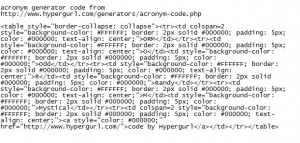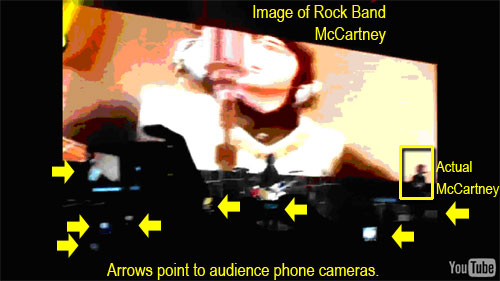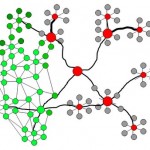Colleague Blog Post Reflections
I have responded to the blogs of Mathieu Reynolds, James Gregory, Susanne Nobles, and Laura Ray. It’s fascinating to see how the concept of “the remediated self†overlaps with Baudrillard’s ideas of simulacra (as Susanne had been responding to Suzanne Sink and Sarah Spangler’s wiki page), Hayles’ idea of the body as prosthesis, and Mathieu’s take of Facebook users’ selecting iconic images to represent themselves.
James had read Remediation as did Wil LaVeist and I. James in essence stated he doesn’t view the internet as different enough from traditional broadcast media as to allow it to go unregulated while broadcast media remains highly regulated. I suggested that the approach to regulating the internet is already in place by virtue of the fact that people’s habits are being monitored. So, perhaps the internet is not quite “the wild frontier†it was perhaps twenty years ago and both are indeed being regulated.
Susanne’s blog was a treat as she’s employing the metaphor of a world explorer in her CSS entries. She also has a way of using light yet highly applicable imagery to support her written text.
Laura’s and Cheri’s wiki page on How We Became Posthuman had been fascinating, so I wanted to see if there was any supplemental angle or info in Laura’s blog. She definitely gave me something to think about in her discussion of Hayles’ quote on analogy, connecting it to material Laura had learned in sociolinguistics. The idea that “[a]nalogy is thus constituted as a universal exchange system that allows data to move across boundaries. It is the lingua franca of a world…†(pg. 98) makes more sense to me now that we’ve read Brooke’s Lingua Franca book. Laura’s entry in particular I found very informative.
I had no idea she has educational experience in Wildlife Biology. Her discussion of how entities (such as frogs) construct what they perceive to be in the world around them made me think of an interesting video on a robot that “learns,” (as well as walks and runs), ASIMO:
James May – ASIMO Robot learns object identity *HQ*
Canonical Book Wiki Page Reflections
I have never read How We Became Posthuman so everything I know about that book comes from the entry I just read. I’m glad I was assigned that work as it is another piece (besides Do Androids Dream of Electric Sheep?) that asks the question “What is human?†To actually consider the body as a type of prosthesis blows my mind! So if being human is actually to float around the shell you’ve been given, then how is that tied to being a type of machine? That sounds more like the idea of spirituality is possible, since it would appear that our humanness is distinct from our materiality. I might pick up this book later. Although now that I’ve read the “Cliff Notes,†maybe I’ve already got the main take-away I’d have gotten if I had read it.
Lev Manovich’s book, The Language of New Media I had read before. I chose to review it because I had read it before. Consequently, I think I made more pointed criticisms of the wiki page, although I thought the draft was a capable start.
Having read these other wiki pages, I think our page would benefit from a table of contents and a small area with the authors’ backgrounds listed.
- How I’m Feeling these DaysImage from http://www.digital-delight.ch
Peer Review Reflections
So we’re supposed to write a reflection of our peer review experience? I can see reading other people’s recaps as helpful. Giving others input may be helpful, sometimes maybe not. However right now, taking precious time to write out a reflection on the process we just went through (critiquing others with a rubric we were handed and answering these questions) is something I do not anticipate needing to return to six months down the line as I work toward my dissertation. I can see going to the wiki pages other people created, but not the process of my critique. If I’m wrong, I’ll be happy to admit it as soon as I find out I need this information.
I’m just feeling a bit overwhelmed right now as I’ve done nothing but work on all the components of this course and there doesn’t seem to be enough hours in the day. Personally, I don’t know how anyone who’s taking more than one course right now is keeping up. The course has been great and I’ve learned alot; this is probably just the worst week in terms of workload because of all the collaboration and prep for our wiki pages, prep for our presentations, reviews of others’ wiki pages, reviews of 4 blog posts, a rhetorical analysis of something in JavaScript, plus more tutorials on learning Javascript, and then finally, all our reflections on all of the above on top of that. Nope, not enough hours in the day; I’m not that fast a reader nor writer. So, I figure I’m allowed to feel a little overwhelmed this week.
Colleague Feedback Reflections
Regarding the input received on our wiki entry for Remediation, Jennifer Buckner and Suzanne Sink were our official reviewers. I was surprised that captions were requested because if they had put their cursor over the images, captions would have (should have?) popped up. The ALT tags are there and they worked for me in IE, but not in my version of Firefox. Granted, I don’t have the latest version of Firefox. Another surprise was the comment that there was a shift in the Conclusion paragraph, which I’m not seeing at all on my computer. I’m happy people liked the images and the decoration. I agree that the decoration should have been used on a few of the latter sections so they didn’t look like they were part of Section III. Overall, I’m thankful for the input.
Tutorial Reflections: JavaScript
I watched 20 videos from the Javascript Essentials Training course from 2001 on Lynda.com. Ironically, the more the course went on, the more I realized it wasn’t telling me what I as a potential programmer needed to know– which was a real-life example. I decided to go back to the JavaScript wiki page of our class to see if the team that did their presentation on Javascript had suggested any other useful tutorial resources. Again, ironically, the one I found that helped me the most came from information on the CSS-XHTML page!
This greatly surprised me as I have always found Lynda’s tutorials very clear, and I did learn some things from Lynda.com. However, the Essentials course was so enmeshed with an assumption that I knew more than I actually do, it became garbled for me and I started to freak out that I wasn’t going to understand JaveScript enough to create my project.
My confusion really picked up when the instructor started talking about what “the DOM†is. It sounds like a Mafioso, but it stands for “Document Object Model.†The way he explained it, the DOM is basically how you consider, frame and assign the components of your programming into a useful structure. That idea is a little abstract, and although I think I have a sense of what it is, it wasn’t what I was needing to create what I wanted to create. I guess I won’t understand how important it is until I work with JavaScript a little more.
I had never heard of Educator.com, but after watching one module on the “IF Logic” in Javascript, I had a very basic framework for an acronym generator that did what I wanted it to do in straight-forward language. I know I’ve still got farther to go, but getting something to work on this basic level brought a much-needed moment of exhilaration! These tutorials on Educator.com made much more sense to me. Not that I’m greedy, but I’d like to figure out if JavaScript will allow me to generate acronyms using some kind of loop and a chart that it retrieves information from. I see there’s a module for loops on Educator.com, but I’m not sure about the $35 price tag when I already basically have what I need to create something useable. My code at this point is admittedly not the most efficient, but it basically works! I also want to have it work with a form instead of a pop-up “alert.”
We’ll see.
Still to come… my rhetorical analysis of something in JavaScript.










